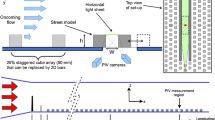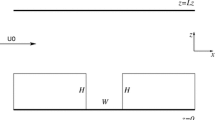Abstract
Coherent flow structures and pollutant dispersion in a spanwise-long street canyon are investigated using a parallelized large-eddy-simulation model. Low- and high-concentration branches, starting from the downwind top corner and upwind bottom corner, respectively, are detected in the time-averaged field of pollutant concentration, and detailed structures of in-canyon flow and pollutant dispersion following the two branches are demonstrated. When turbulent eddies impinge on the upper downwind wall, low- and high-concentration blobs with U-shaped flow structures appear and move downward. The downdrafts tilt away from the downwind bottom corner and impinge on the canyon bottom, driving horizontally diverging flows. Cellular structures of low-concentration centres and high-concentration edges are induced by the downdrafts and diverging flows. The diverging flows push low-concentration air toward the downwind and upwind building walls, resulting in local divergence and convergence of pollutants on both walls. Time series of pollutant concentration at multiple points illustrate that pollutant concentration at the pedestrian level is highly sensitive to the diverging flows. The multiresolution spectra show that time scales of variations of pollutant concentration and vertical velocity component increase from the canyon top to the pedestrian-level centre, indicating longer time-scale flow structures are dominant inside the street canyon. The multiresolution cospectra also show that the time scale of vertical turbulent transport of pollutants increases from the canyon top to the pedestrian-level centre. At the two bottom corners, however, short and long time-scale transports occur together, confirming that the low-concentration diverging flows transport pollutants downward while short time-scale turbulence transports pollutants upward.









Similar content being viewed by others
References
Arakawa A, Lamb VR (1977) Computational design of the basic dynamical processes of the UCLA general circulation model. Methods Comput Phys 17:173–265
Baik JJ, Kim JJ (1999) A numerical study of flow and pollutant dispersion characteristics in urban street canyons. J Appl Meteorol 38(11):1576–1589
Baik JJ, Kim JJ (2002) On the escape of pollutants from urban street canyons. Atmos Environ 36(3):527–536
Belcher SE (2005) Mixing and transport in urban areas. Philos Trans R Soc 363(1837):2947–2968
Belcher SE, Coceal O, Goulart EV, Rudd AC, Robins AG (2015) Processes controlling atmospheric dispersion through city centres. J Fluid Mech 763:51–81
Britter RE, Hanna SR (2003) Flow and dispersion in urban areas. Annu Rev Fluid Mech 35:469–496
Caton F, Britter R, Dalziel S (2003) Dispersion mechanisms in a street canyon. Atmos Environ 37(5):693–702
Cui Z, Cai X, Baker CJ (2004) Large-eddy simulation of turbulent flow in a street canyon. Q J R Meteorol Soc 130(599):1373–1394
Deardorff JW (1980) Stratocumulus-capped mixed layers derived from a three-dimensional model. Boundary-Layer Meteorol 18(4):495–527
Duan G, Jackson JG, Ngan K (2019) Scalar mixing in an urban canyon. Environ Fluid Mech 19(4):911–939
Eliasson I, Offerle B, Grimmond CSB, Lindqvist S (2006) Wind fields and turbulence statistics in an urban street canyon. Atmos Environ 40(1):1–16
Gentine P, Garelli A, Park SB, Nie J, Torri G, Kuang Z (2016) Role of surface heat fluxes underneath cold pools. Geophys Res Lett 43(2):874–883
Han BS, Baik JJ, Kwak KH, Park SB (2018) Large-eddy simulation of reactive pollutant exchange at the top of a street canyon. Atmos Environ 187:381–389
Howell JF, Mahrt L (1997) Multiresolution flux decomposition. Boundary-Layer Meteorol 83(1):117–137
Kwak KH, Lee SH, Seo JM, Park SB, Baik JJ (2016) Relationship between rooftop and on-road concentrations of traffic-related pollutants in a busy street canyon: ambient wind effects. Environ Pollut 208:185–197
Letzel MO, Krane M, Raasch S (2008) High resolution urban large-eddy simulation studies from street canyon to neighbourhood scale. Atmos Environ 42(38):8770–8784
Lo KW, Ngan K (2017) Characterizing ventilation and exposure in street canyons using Lagrangian particles. J Appl Meteorol Climatol 56(5):1177–1194
Maronga B, Moene AF, van Dinther D, Raasch S, Bosveld FC, Gioli B (2013) Derivation of structure parameters of temperature and humidity in the convective boundary layer from large-eddy simulations and implications for the interpretation of scintillometer observations. Boundary-Layer Meteorol 148(1):1–30
Maronga B, Gryschka M, Heinze R, Hoffmann F, Kanani-Sühring F, Keck M, Ketelsen K, Letzel MO, Sühring M, Raasch S (2015) The Parallelized Large-Eddy Simulation Model (PALM) version 4.0 for atmospheric and oceanic flows: model formulation, recent developments, and future perspectives. Geosci Model Dev 8(8):2515–2551
Maronga B, Banzhaf S, Burmeister C, Esch T, Forkel R, Fröhlich D, Fuka V, Gehrke KF, Geletič J, Giersch S, Gronemeier T, Groß G, Heldens W, Hellsten A, Hoffmann F, Inagaki A, Kadasch E, Kanani-Sühring F, Ketelsen K, Khan BA, Knigge C, Knoop H, Krč P, Kurppa M, Maamari H, Matzarakis A, Mauder M, Pallasch M, Pavlik D, Pfafferott J, Resler J, Rissmann S, Russo E, Salim M, Schrempf M, Schwenkel J, Seckmeyer G, Schubert S, Sühring M, von Tils R, Vollmer L, Ward S, Witha B, Wurps H, Zeidler J, Raasch S (2020) Overview of the PALM model system 6.0. Geosci Model Dev 13(3):1335–1372
Marshall JD, Brauer M, Frank LD (2009) Healthy neighborhoods: walkability and air pollution. Environ Health Perspect 117(11):1752–1759
McWilliams JC (1990) A demonstration of the suppression of turbulent cascades by coherent vortices in two-dimensional turbulence. Phys Fluids A 2(4):547–552
Michioka T, Sato A (2012) Effect of incoming turbulent structure on pollutant removal from two-dimensional street canyon. Boundary-Layer Meteorol 145(3):469–484
Oke TR (1988) Street design and urban canopy layer climate. Energy Buil 11(1–3):103–113
Oke TR, Mills G, Christen A, Voogt JA (2017) Urban climates. Cambridge University Press, Cambridge
Oleson KW, Bonan B, Feddema J, Vertenstein M, Grimmond CSB (2008) An urban parameterization for a global climate model. Part I: formulation and evaluation for two cities. J Appl Meteorol Climatol 47(4):1038–1060
Park SB, Baik JJ, Raasch S, Letzel MO (2012) A large-eddy simulation study of thermal effects on turbulent flow and dispersion in and above a street canyon. J Appl Meteorol Climatol 51(5):829–841
Park SB, Baik JJ, Ryu YH (2013) A large-eddy simulation study of bottom-heating effects on scalar dispersion in and above a cubical building array. J Appl Meteorol Climatol 52(8):1738–1752
Park SB, Baik JJ, Lee SH (2015) Impacts of mesoscale wind on turbulent flow and ventilation in a densely built-up urban area. J Appl Meteorol Climatol 54(4):811–824
Park SB, Böing S, Gentine P (2018) Role of surface friction on shallow nonprecipitating convection. J Atmos Sci 75(1):163–178
Pavageau M, Schatzmann M (1999) Wind tunnel measurements of concentration fluctuations in an urban street canyon. Atmos Environ 33(24–25):3961–3971
Rotach M (1995) Profiles of turbulence statistics in and above an urban street canyon. Atmos Environ 29(13):1473–1486
Ryu YH, Baik JJ, Lee SH (2011) A new single-layer urban canopy model for use in mesoscale atmospheric models. J Appl Meteorol Climatol 50(9):1773–1794
Sini JF, Anquetin S, Mestayer PG (1996) Pollutant dispersion and thermal effects in urban street canyons. Atmos Environ 30(15):2659–2677
Uehara K, Murakami S, Oikawa S, Wakamatsu S (2000) Wind tunnel experiments on how thermal stratification affects flow in and above urban street canyons. Atmos Environ 34(10):1553–1562
Vickers D, Mahrt L (2003) The cospectral gap and turbulent flux calculations. J Atmos Ocean Tech 20(5):660–672
Walton A, Cheng A (2002) Large-eddy simulation of pollution dispersion in an urban street canyon–part II: idealised canyon simulation. Atmos Environ 36(22):3615–3627
Wicker LJ, Skamarock WC (2002) Time-splitting methods for elastic models using forward time schemes. Mon Weather Rev 130(8):2088–2097
Williamson J (1980) Low-storage Runge–Kutta schemes. J Comput Phys 35(1):48–56
Xie ZT, Castro IP (2006) LES and RANS for turbulent flow over arrays of wall-mounted obstacles. Flow Turbul Combust 76(3):291–312
Xie ZT, Castro IP (2009) Large-eddy simulation for flow and dispersion in urban streets. Atmos Environ 43(13):2174–2185
Yaghoobian N, Kleissl J, Paw U KT (2014) An improved three-dimensional simulation of the diurnally varying street-canyon flow. Boundary-Layer Meteorol 153(2):251–276
Zhong J, Cai XM, Bloss WJ (2015) Modelling the dispersion and transport of reactive pollutants in a deep urban street canyon: using large-eddy simulation. Environ Pollut 200:42–52
Acknowledgements
The authors are grateful to two anonymous reviewers for providing valuable comments on this study. This work was supported by the Research Institute of Basic Sciences funded by the National Research Foundation of Korea (NRF-2019R1A6A1A10073437), and by the Small Grant for Exploratory Research (SGER) program through the National Research Foundation of Korea (NRF-2018R1D1A1A02086007).
Author information
Authors and Affiliations
Corresponding author
Additional information
Publisher's Note
Springer Nature remains neutral with regard to jurisdictional claims in published maps and institutional affiliations.
Rights and permissions
About this article
Cite this article
Park, SB., Baik, JJ. & Han, BS. Coherent Flow Structures and Pollutant Dispersion in a Street Canyon. Boundary-Layer Meteorol 182, 363–378 (2022). https://doi.org/10.1007/s10546-021-00669-3
Received:
Accepted:
Published:
Issue Date:
DOI: https://doi.org/10.1007/s10546-021-00669-3




